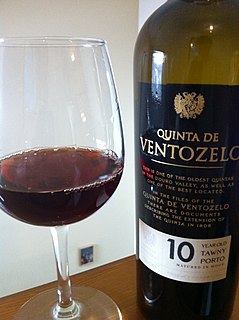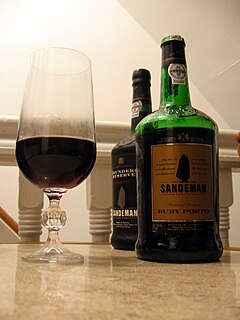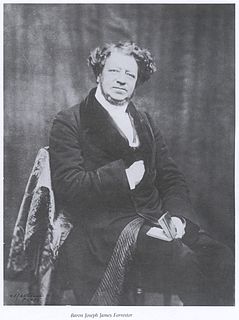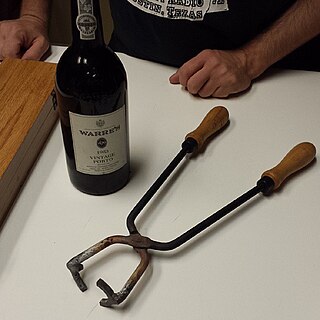Related Research Articles

Cork is an impermeable buoyant material, the phellem layer of bark tissue that is harvested for commercial use primarily from Quercus suber, which is native to southwest Europe and northwest Africa. Cork is composed of suberin, a hydrophobic substance. Because of its impermeable, buoyant, elastic, and fire retardant properties, it is used in a variety of products, the most common of which is wine stoppers. The montado landscape of Portugal produces approximately half of cork harvested annually worldwide, with Corticeira Amorim being the leading company in the industry. Cork was examined microscopically by Robert Hooke, which led to his discovery and naming of the cell.

Port wine is a Portuguese fortified wine produced in the Douro Valley of northern Portugal. It is typically a sweet red wine, often served as a dessert wine, although it also comes in dry, semi-dry, and white varieties.

Peso da Régua, commonly known as Régua, is a municipality in northern Portugal, in the district of Vila Real. The population in 2011 was 17,131, in an area of 94.86 km2 (36.63 sq mi) km².
Alvarelhão is a red wine grape grown in northern Portugal.

The Radium King was built in 1937 to haul ore on the Mackenzie River, and her tributaries. This included uranium used in the US atom bombs of World War II. Later in her active career she hauled barges on Great Slave Lake.

Santa Marta de Penaguião is a Portuguese municipality in the district of Vila Real, in the northern region of Douro. The population in 2011 was 7,356, in an area of 69.28 km².

Sabrosa is a municipality in the district of Vila Real in northern Portugal. The population in 2011 was 6,361, in an area of 156.92 km².

Alijó is a municipality in the Norte Region of Portugal, located in the district of Vila Real. The population in 2011 was 11,942, in an area of 297.60 km2.

São João da Pesqueira is a municipality and municipal seat in the Portuguese district of Viseu. The population of the municipality in 2011 was approximately 7,874 inhabitants, in an area that extends 266.11 square kilometres (102.75 sq mi). The present mayor is Manuel Cordeiro, elected by a citizens' movement. The municipal holiday is June 24.

Wine corks are a stopper used to seal wine bottles. They are typically made from cork, though synthetic materials can be used. Common alternative wine closures include screw caps and glass stoppers. 68 percent of all cork is produced for wine bottle stoppers.
John Pollack is an American originally from Ann Arbor, Michigan who served as a Special Assistant to the President and Presidential Speechwriter for Bill Clinton, as a foreign correspondent, and as an advisor to leaders and philanthropists. Now a consultant, Pollack is a noted authority on analogy, wordplay, creativity and innovation.

The history of Portuguese wine has been influenced by Portugal's relative isolationism in the world's wine market, with the one notable exception of its relationship with the British. Wine has been made in Portugal since at least 2000 BC when the Tartessians planted vines in the Sado and Tagus valleys. By the 10th century BC, the Phoenicians had arrived and introduced new grape varieties and winemaking techniques to the area. Up until this point, viticulture was mostly centered on the southern coastal areas of Portugal. In later centuries, the Ancient Greeks, Celts and Romans would do much to spread viticulture and winemaking further north.
James Dodds is an East Anglian artist whose practice centers on painting, linocut and relief carving. Born in Brightlingsea, Essex, he now lives and works in Wivenhoe producing prints and books as the Jardine Press. He is the son of East Anglian artist Andrew Dodds and has been described as "boatbuilding’s artist laureate". He is arguably East Anglia's most famous contemporary artist after Dame Maggi Hambling.

Joseph James Forrester was an English merchant and wine shipper.

Carrapatelo Dam is a concrete gravity dam on the Douro, where the river forms the border line between the districts of Porto and Viseu. It is located in the municipalities of Marco de Canaveses, in Porto District, and Cinfães, Viseu District, Portugal.

Pocinho Dam is a concrete gravity dam on the Douro, where the river forms the border line between the districts of Guarda and Bragança. It is located in the municipality Vila Nova de Foz Côa, in Guarda District, Portugal.
India Arrow was a steam tanker built in 1921 by Bethlehem Shipbuilding Corporation of Quincy for Standard Oil Co., with intention of transporting oil and petroleum products between United States and the Far East. After serving for approximately ten years in the Pacific trade, the tanker was moved to intercoastal trade routes in early 1930s where she remained for the rest of her career. The vessel was torpedoed and sunk by the German submarine U-103 in February 1942 during one of her routine trips from Texas to New York with a loss of twenty six of her crew.

City of Ragusa of Liverpool was a 20-foot (6 m) yawl, owned by Nikola Primorac, which twice crossed the Atlantic in the early days of 19th-century small-boat ocean-adventuring. She carried the former alternative name of Dubrovnik, the birthplace of her owner. She was originally a ship's boat of a merchantman. The 1870 east-west trip between Ireland and the United States was crewed by John Charles Buckley, a middle-aged Irishman with seagoing experience, and Primorac, a Croatian and tobacconist. The crew on the west–east return trip of 1871 were Primorac and a "lad" called Edwin Richard William Hayter from New Zealand, who had been a steward on the steamer City of Limerick of the Inman Line.

Port tongs are a special set of tongs designed to open wine bottles that are sealed with a cork. The tongs are heated over an open flame and held against the neck of the wine bottle for 20–30 seconds. The heated section of bottle is then cooled with a damp cloth or ice water, causing the glass to fracture due to thermal expansion. The result is generally a clean, predictable break. Any possible shards of glass are strained out, along with any sediment, when pouring the wine into a decanter.
References
- ↑ Cork Boat
- ↑ Whitney Duncan. "Bobbing Through Portugal on Boat Made of Wine Corks" . Retrieved 2007-07-27.CS1 maint: discouraged parameter (link)
- ↑ Gretchen Giles. "If I Had a Boat". Archived from the original on 2007-08-16. Retrieved 2007-07-27.CS1 maint: discouraged parameter (link)
- ↑ "Sink or swim as cork boat takes to the water" . Retrieved 2007-07-27.CS1 maint: discouraged parameter (link)
- ↑ R. KRITHIKA (2002-07-13). "Cork boat sail". The Hindu . Chennai, India. Archived from the original on 2003-08-26. Retrieved 2007-07-27.CS1 maint: discouraged parameter (link)